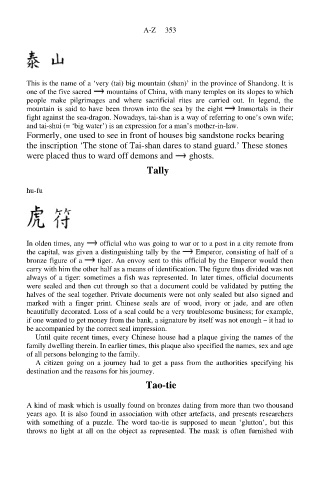Page 360 - A Dictionary of Chinese Symbols BIG Book
P. 360
A-Z 353
This is the name of a ‘very (tai) big mountain (shan)’ in the province of Shandong. It is
one of the five sacred mountains of China, with many temples on its slopes to which
people make pilgrimages and where sacrificial rites are carried out. In legend, the
mountain is said to have been thrown into the sea by the eight Immortals in their
fight against the sea-dragon. Nowadays, tai-shan is a way of referring to one’s own wife;
and tai-shui (= ‘big water’) is an expression for a man’s mother-in-law.
Formerly, one used to see in front of houses big sandstone rocks bearing
the inscription ‘The stone of Tai-shan dares to stand guard.’ These stones
were placed thus to ward off demons and ghosts.
Tally Tally
hu-fu
In olden times, any official who was going to war or to a post in a city remote from
the capital, was given a distinguishing tally by the Emperor, consisting of half of a
bronze figure of a tiger. An envoy sent to this official by the Emperor would then
carry with him the other half as a means of identification. The figure thus divided was not
always of a tiger: sometimes a fish was represented. In later times, official documents
were sealed and then cut through so that a document could be validated by putting the
halves of the seal together. Private documents were not only sealed but also signed and
marked with a finger print. Chinese seals are of wood, ivory or jade, and are often
beautifully decorated. Loss of a seal could be a very troublesome business; for example,
if one wanted to get money from the bank, a signature by itself was not enough – it had to
be accompanied by the correct seal impression.
Until quite recent times, every Chinese house had a plaque giving the names of the
family dwelling therein. In earlier times, this plaque also specified the names, sex and age
of all persons belonging to the family.
A citizen going on a journey had to get a pass from the authorities specifying his
destination and the reasons for his journey.
Tao-tie Tao-tie
A kind of mask which is usually found on bronzes dating from more than two thousand
years ago. It is also found in association with other artefacts, and presents researchers
with something of a puzzle. The word tao-tie is supposed to mean ‘glutton’, but this
throws no light at all on the object as represented. The mask is often furnished with

